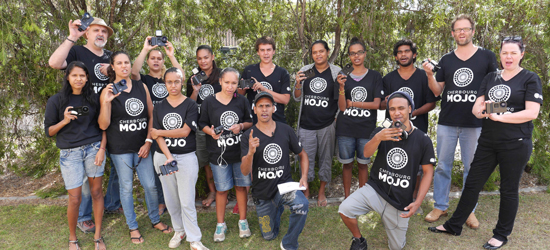What happens when you give a group of young Indigenous students in Cherbourg a nifty iPhone 5 production kit, and ask them to report back with stories about their community? According to Ivo Burum, the pioneer of the MoJo (mobile journalism) concept, you uncover some very powerful storytellers.
Based on the participatory journalism trialled in Yuendumu in the 1970s, the MoJo program was developed by Ivo in 1992 when he was working for the ABC.
During the course, students are provided with an iPhone 5 production kit that includes a microphone, flash, tripod and a range of lenses. They are taught how to use the technology and then produce their own media content from the initial story idea – all the way through to filming and final editing.
The guiding principle behind the program is storytelling and, more specifically, enabling marginalised communities to tell their own stories.
“Its roots are based in empowering ordinary people to tell extraordinary stories,” says Ivo. “It enables people in these remote communities to be able to come up with, create and publish their own stories.”
As technology has advanced, the scope and trajectory of the MoJo course has widened.
“One of the great things about the program is that the skills that I’m teaching these young people in Cherbourg are the same skills that I’m teaching to journalists at Fairfax and a number of big media organisations in Europe,” says Ivo.
“As the technology has become more powerful, it’s become broadcast-quality. We are all using the same technology now, so what we are doing is fashioning a skill-set around it to create a common digital language, which is what I’m trying to do across three spheres of communication, community, education and mainstream media.”
The experience of learning about new technology and sharing stories about their community has had a positive effect for all of the students involved. They report feeling more confident and see the program as providing real benefits to their community.
“It benefits our community because we get to tell our own stories and show the good things about Cherbourg – so people don’t just see the negative,” says Mojo student Shayah Watson-Bell.
Another student, Danielle Georgetown, said her favourite part of the course was, “using the iPhone and telling my own stories, showing that I could do it for myself and tell my part of the story with confidence”.
Danielle has produced a story on the Ration Shed Museum, which is a historically significant site in Cherbourg. She has done a lot of study in the past, but feels that the MoJo course in particular has been very beneficial.
“I have achieved a lot of goals but feel that this has changed my life,” says Danielle. “It could be this way for others as well if they come and try MoJo, because it’s about telling your side of the story. I think it could change people’s lives and give them a chance to give back to the community as well.
As for the technology… “It was a bit tricky at the start, but we’ve improved a lot. I’m using it like a pro now,” she laughs.
The stories that have been produced so far, present a varied and interesting glimpse into life within the Cherbourg community. From reports on the Safe Haven Program, the Art Centre book launch and the Bunya Mountains Corroboree, you get the sense that the students filming the stories are also discovering new things about their community that they weren’t previously aware of.
Santina Schmocker, the Campus Business Co-ordinator at Nurunderi TAFE, has observed a significant change in the students since the program kicked off.
“It has been an absolute delight to see the young folk that are involved in this project, come on to the campus,” she says.
“It’s always a big step for anybody to engage in a program, but they have taken the step. Some of them were quite shy, some were very nervous, others not so enthusiastic, but when you see them today, with their head held high, exuding confidence and self-esteem, that in itself is an incredible outcome. What they are actually producing with confidence is outstanding,” said Santina.
A ceremony is being held during NAIDOC week this month where three of the students will win awards, including the iPhone kit they have been using throughout the course.
The awards will be based on creativity, most outstanding overall and attendance.
Ivo will undoubtedly be looking on with pride as students who were reluctant to have a conversation at the beginning of the course stand proudly, confident in the knowledge that their stories matter and that they now have the ability to communicate these stories in their own way.
“These are the oldest storytellers in the world using the latest technology to tell remarkable – stories from their own perspective,” says Ivo.
“I’m excited to see what we can learn from them.”

Comments are closed.